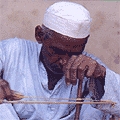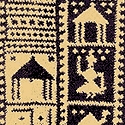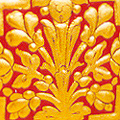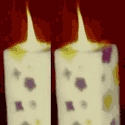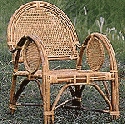Quitabat or Calligraphy is practiced in Lucknow by skilled calligraphers since centuries. The art was first brought to India by Turkish Sultans in 1200 AD. Many examples of unparalleled calligraphy can be found from this period where several Persian and Arabic texts were reproduced and illustrated in Iranian styles, incorporating Indian elements. Tughra, a complex and stylized calligraphic style was used by Turkish sultans as their monographs. Tools such as brushes, reed pens/bet muishk, agate for burnishing and fixing colours, jade for mixing gold foil and paint and opal for burning are used by the calligraphers.
Carved stones with Buddhist calligraphy are found in many places in Nepal. These stones have traditionally been placed along paths that lead to monasteries. In recent years religious iconography and calligraphy carved into stones is also being done for the tourist market.
In old Delhi a family still continue engraving stones for the graves in calligraphy. The art of engraving gravestones or Kunda karma is a painstaking task and requires immense patience and endurance. The cost of gravestone ranges from Rs. 300/- to Rs 1000/- depending on the kind of stone and number of words engraved.
Lucknow has been a prominent center for ivory carving. From creating court objects for the Nawabs of Awadh to carrying out the craft on furniture as initiated by the British, ivory carving has been a significant part of the craft repertoire. Due to the worldwide ban on ivory, the the craftsmen has since been carving on camel and buffalo bone. Products like openwork boxes, lamps, scissors, paper knives, pen stands, buttons, earrings, necklaces, rings, pendants and ambari elephant are crafted by the artisans.
These are called the split ply camel girths of Rajasthan. They are worked by hand and the loom is not used; they are simple, decorative and useful. The sturdy girths of the camels are prepared using a unique technique mainly using goat hair; cotton cord is also used sometimes. The black or white hair of the goat is woven into yarn on the spindle. The yarn is doubled to make it two-ply; four-ply yarn is used for girth, with each ply being two-ply. To make the four-ply yarn a mixture of black and white, two white two-plys are plied with two black two-plys. The four-ply is highly twisted as it needs to be manipulated, twisted and untwisted in the processing. After twisting, the four-ply yarn is soaked in water and stretched out in the sun to dry. This removes the kinks, opens up and thickens out the yarn and sets the over twist. When the yarn is dry, the four-ply cords are looped and slipped on to a wooden stick or spindle. The adjacent plys are taken, and the ply of one cord is split open with the eye end of a large wooden needle and untwisted to a quarter of a turn; the next cord is threaded through the eye and is pulled back through the first strand. The adjacent cords have this process done along the row, and worked down, row by row, where each individual cord reaches down and across the newly created fabric on a diagonal line ending on the selvedge. The direction of the cord turns down and across in the opposite side and ultimately zigzags down the fabric from selvedge to selvedge. The pattern is decided by the girth-maker who decides whether the cord is split or to be split by the cord it meets along the opposite diagonal. There are standard variations in pattern. These are monochrome (some colour, mainly black), a black and white diagonally chequered pattern, or alternating black and white horizontal waves. The best pattern is when the four ply yarn is half black and half white. The cord here is untwisted in the cord splitting process so that two plys of the same colour remain on the surface. The diagonally interlaced layer of one colour lies on the top of the diagonally interlaced layer of the other colour in the refined technique. When the cord is twisted, colours are counter-changed and the free-floating layers are linked together. Items such as camel girth, necklace, anklet, knee band, bridle etc are created under this craft-form. Tools such as wooden hook are used for crafting purposes.
Bikaner, one of the three main destinations in the tourist desert circuit of Rajasthan is known as camel country as the camels here are said to be best in the world for riding purposes. Bikaner also boasts of the largest Camel research and breeding farm in the World which was initiated by the central government. The National research center for Camel not only researches the camel, and in all its aspects - hair and milk etc. Bikaner has also been known for the use put to camel skin including the crafting of handmade objects. The community of dapgars process the skin of camel to make traditional Rajasthani drums and camel skin decorative items from bottles, vases, bowls etc. There is only one traditional dapgar family in Bikaner still processing the camel skin for usage. They make objects like flasks, bottles and vases from camel skin. The objects made by them are used bythe well known Usta community to paint them in Gesso or Usta kaam.
The camel skin is cleaned with the help of a scraper or "rambi". The hair is also removed with another "rambi". The damp skin is cut into smaller pieces and pounded flat with a rounded grinder. Thus cleaned and treated, the small pieces of skin are stretched and pasted mounted on to a mould of desired shape with the use of the hands. Any gap between the pieces is checked and refilled with "gooda" (paste). Checked again. This is dried in the sun. When dry, the mould inside is broken and the skin which has acquired the shape of the mould, cleaned and dried. The object is then ornamented with multicoloured lacquer painting of designs of floral and geometric patterns bearing distinct Mughal and Persian influence. Three major craftsmen are namely the Kumhar (potter), the dabgar (the camel skin worker) and Naqqash (the painter).
Menawati or candle making is a traditional craft. Made by pouring molten wax (earlier beeswax collected in the jungles) into moulds in which there is a cotton wick, the other process followed is by pouring molten wax down a wick. White candles and arrange of other color candles are made using chemical color additives.
Candle making is practiced all across India. However, there are always regional variations.
Candle making is practiced all across India. However, there are always regional variations present.
Candle making is practiced all across India. However, there are always regional variations present.
Candle making is practiced all across India. However, there are always regional variations present.
Candle making is practiced all across India. However, there are always regional variations present.
Candles are used in Goa at Christian rituals, at rites of passage - baptisms and weddings - and festive occasions in Goa - across Churches and at home candles are lit and used. Menawati or candle making is a traditional craft. Made by pouring molten wax (earlier beeswax collected in the jungles) into moulds in which there is a cotton wick, the other process followed is by pouring molten wax down a wick. White candles and arrange of other color candles are made using chemical color additives. Candles are made by local people across Goa but mainly in the North in Divar Island and Calangute.
Candle making is practiced all across India. However, there are always regional variations present.
Candle making is practiced all across India. However, there are always regional variations present.
Throughout Bhutan, cane and bamboo products have always complemented wood as the most commonly used material to produce items of everyday use. Cane and bamboo have been made into storage containers, baskets for carrying food, utensils, musical instruments, bows and arrows, walls for houses, fences, ropes, and floor mats. The abundant and lush forests in the Himalayan foothills provide the raw material. Over a hundred varieties of cane and bamboo plants thrive in the rain fed forests and are often combined with hard and soft wood from the oak, cedar, maple walnut, and other varieties of wood. The bamboo or rattan is cut into thin strips, braided, and coloured to form geometric designs; sometimes the natural colouring is left as is. The colours used include yellow, green, natural brown-green, blue-purple, and maroon.
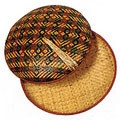
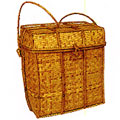

- Tsezem: Basket These baskets are used to store dried meat and carry all kinds of food and articles and often used as shopping bags.
- Lakchung: Basket Traditionally used as a fruit container and for serving dry food items on special occasions and ceremonies. This basket is multi-purpose and is often used as a waste-paper basket or a flower vase.
- Beykhur: Gift Box This basket has a square shape and is traditionally used for storage of yarns.
- Bello: Hat The bello is used by farmersto protect themselves from sun and rain.
- Bangchu: Round Bamboo Plate The Bangchu is traditionally used as a rice plate and for carrying pack-lunches. Also used as a container for serving snacks.
- Poe: Incense Sticks Incense sticks are used daily as offerings to Buddhas, Bodhisattvas, and protective deities and celestial beings. Zurpoe is a Special Incense prepared according to ancient traditions using a blend of more than one hundred precious aromatic and medicinal substances like nagi (scale of Pangolin), musk, red and white sandalwood, giwang (Bezoar), clove, nutmeg, saffron etc...
- Poe Palang: Incense Container These are used for storing incense sticks (poe) in dzongs, monasteries, and households all over the country.
- Jatsa: Tea Strainer Sieves made of plain bamboo are traditionally used for straining butter-tea and milk in Bhutanese households.
- Sipa: Butter & Cheese Container Made of wood and bamboo, these containers were traditionally used to hold butter and cheese. It is ususally either round or oval in shape.
- Palang: Alcohol and Water Container Made of bamboo - they are traditionally used to store and serve alcohol and water.
- Zhu: Bow & Dha: Arrows The Bhutanese arrow (dha) is made of bamboo with a feather-head and metal point.The Bhutanese bow (zhu) is made from a bamboo species prevalent in the foothills of Bhutan. The best bamboo is found in the villages of Taba and Damtey in Samtse.
- Soray Palang: Quiver Traditionally the quiver is made of wood and bamboo.
- Dala Is used for dehusking rice.
- Mats Finely woven mats are a common and popular craft item. Split cane is used in its natural colour or dyed to form patterns. Mats can be found in almost any size up to about 16 square feet.
Traditionally, the Mahar community makes bamboo products that are used by fishermen for functional purposes. Bamboo is locally available, in Pernem, Bicholim, Bardez, Tiswadi, and Sattari districts of Goa while the craft is practiced in the South Goa districts of Madgaon and Cuncolim; and the North Goa districts of Porvorim, Pernem, Bicholim and Mangueshi. The products are available in the weekly markets and in all the markets across Goa.
To craft the bamboo the craftsmen soak the bamboo for two or three days in sea water for seasoning, it is then sun-dried. When completely dry it is segmented. The outermost layer of the bamboo or skin is removed completely. The pith inside is removed and used as fuel. The bamboo is then cut into strips. These strips are further cut into splits that are used for weaving the basket. The baskets are made only with the inner part. The tools used are basic and include the Koyto-large knife and the Sun or small blunt knife. To colour the splits, chemical colours are boiled in water, and the strips are left in this solution for half an hour and dried.
A huge range of utility products like baskets, boxes, flower vases, winnowing trays, chicken baskets, grain baskets, partitions, fans, and mats are made from bamboo strips in Goa.
The history of the bamboo reed industry of Kerala may be traced to the 14th century when the Arab traveler, Ibn Batuta, recorded the use of bamboo mats as sails on the Chinese ships at Kozhikode. This most utilitarian yet critical craft of weaving reed baskets and mats is practiced across Kerala though the largest concentration of craftspeople is in Angamally, Thiruvananthapuram, Dedunganda, Aryanad in Ernakulam district and in Malapuram. Other areas of production include Kodali in Thrissur district; Nileswaram and Malapura. The basketry of Kerala is largely made by the Christian communities of Ernakulam and Thrissur. Traditionally, however, it was the Parayas and Kaatakaras (literally, forest people) of Anapandan, a hillside near Thrissur who undertook the making of cane and bamboo baskets using plain, twill and occasionally the hexagonal weave. A large range of painted and woven mats that are crafted are in great demand all over India. The main centre for this craft is Irinjalakuda. The thick bamboo locally known as mula and the thinner bamboo called eeta are made into rough bamboo mats used as wall partitions and softer grass mats to sleep on. Kotta or rough work baskets with short handles are often reinforced with coir; vatti or neatly woven square baskets made with slim bamboo splits are used for shopping, storage as well as a makeshift vessel. The products are usually daubed over or smoked. A wide variety of decorative baskets and shopping bags, bamboo-reed table mats, and other articles are crafted with the craftspeople producing the reed baskets and mats for a wide range of uses suitable to farming, fishing and other activities and requirements of the villages from mats for drying grain, peppercorns, coconut kernels and fish; baskets for vegetable and fish vendors to carry their wares to the local market; muram the winnowing basket for separating chaff; baskets for storing grain; as table mats, wall hangings, table top products like fruit baskets etc. The bamboo mats often serving as partitions and screens in hotels, shops and homes in rural Kerala. Beautifully proportioned bamboo boxes in a combination of black and white twill design worked in bands are also a popular item Cane, a climbing palm with long, thin, solid, joined stems, grows to a great height, climbing over the highest trees to 500 or 600 feet. The stems are dried after their green sheath is removed and dried. Cane is extremely strong and when twisted together can be used as cables or cords. Cane is mainly made into furniture, baskets, tiffin carriers, and fans



